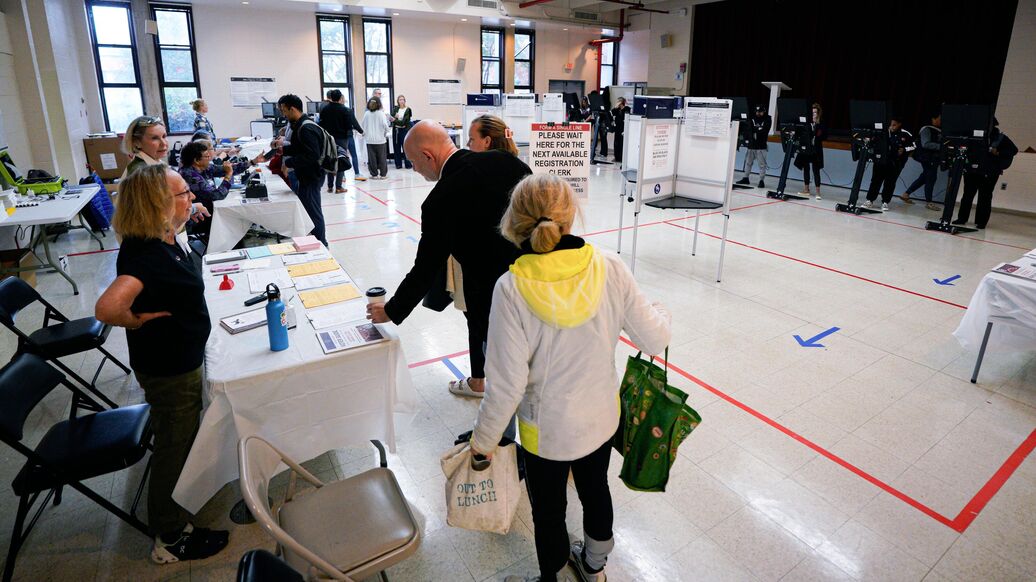How the Electoral College works - and why 270 votes will decide if Trump or Harris wins the 2024 election
When the Founding Fathers argued about how the newly-formed United States would elect a president, they compromised on a unique system that became known as the Electoral College.
When the Founding Fathers argued about how the newly-formed United States would elect a president, they compromised on a unique system that became known as the Electoral College.
It requires a candidate to reach 270 out of 538 total electoral votes. How that math plays out has changed election by election, candidate by candidate.
For the 2024 contest polling shows that most of the 538 votes are already sewn up by Donald Trump or Kamala Harris - but 93 are still up for grabs in seven battleground states.

Seven states are considered swing states in the 2024 presidential race with 93 electoral votes up for grabs, but the path to the White House will come down to who wins Pennsylvania, Georgia and North Carolina

Boxes containing Electoral College votes from the 2020 election are opened during a joint session of the House and Senate on January 6, 2021
The process behind the Electoral College is outlined in Article Two of the U.S. Constitution.
Each state gets as many electors as it has members of Congress - those in the House and the Senate. There are currently 538 electors in all, including three for Washington D.C., which is represented despite not being a state.
Voters head to the polls on the Tuesday after the first Monday in November – that is November 5th in this years election.
After the results, the individuals chosen as electors meet in the state capitals on the first Tuesday after the second Wednesday of December (that is December 17th for this year) to cast their votes for President and Vice President. They then submit their votes to both houses of Congress.
Congress then certifies the results of the election during a joint session, typically held on January 6th – a date that has come to live in infamy after the riot at the Capitol when lawmakers met to certify the results of the 2020 contest.
The complex nature of the Electoral College has been controversial since it was established at the Constitutional Convention in 1787.
Supporters argue that it requires presidential candidates to have broad appeal across the country to win, while critics claim it is not representative of the popular will of the nation.
The Electoral College came about during the Constitutional Convention after a long debate over how to elect the president.
Some Founding Fathers wanted Congress to decide and some wanted it to be a popular vote.
At the time of the Convention, no other country in the world directly elected its chief executive, so the delegates were in uncharted waters.
But some delegates worried if Congress made the decision it would offer too many chances for corruption between the executive and legislative branches.
However, others worried that 18th Century voters lacked the resources to be fully informed about the candidates, especially in rural outposts.
They feared a popular vote could lead to a charismatic megalomaniac winning over a mob of voters and taking the White House.
An Electoral College was the compromise.
The decision also gave more power to slave states and small states.
Slave states wanted to increase their voting power (since they could count slaves as 3/5 of a person when allocating electors) and small states would be guaranteed a minimum of three electors per state.
While polls show most voters dont like the Electoral College there is no easy alternative.
I think one of the challenges is just that its to reach a consensus about what would be a better alternative, Costas Panagopoulos, a professor at Northeastern University who is an expert on the Electoral College, told DailyMail.com.
Each of those alternatives is going to create biases in favor or against certain types of places, he noted.


Donald Trump and Kamala Harris are each trying to win the 270 electoral votes necessary to become president

The Signing of the Constitution of the United States, with George Washington, Benjamin Franklin, and Thomas Jefferson at the Constitutional Convention of 1787; oil painting on canvas by Howard Chandler Christy, 1940. The painting is 20 by 30 feet and hangs in the United States Capitol building.
The Electoral College gives importance to battleground states that are must-wins for candidates. But switching to a popular vote system, for example, would give heavily populated areas – like New York, California and Texas – the advantage.
Additionally, its simply difficult to change the Constitution, which is what is required to establish a new election system. A constitutional amendment requires a two-thirds supermajority in Congress plus ratification by three-fourths of the states.
The majority of states have adopted a winner take all approach when it comes to awarding their electors. Maine and Nebraska are different as they distribute their electoral votes by the winner of each of their congressional districts.
Both Kamala Harris and Donald Trumps campaigns have devised paths toward victory, a strategy of which states to win to give them the necessary 270 votes in the college.
There are 225 electoral votes considered solidly or likely Democratic, meaning theyd go to Harris while 218 are seen as likely to go to Trump.
To reach 270, Harris is eyeing the three blue wall states - Michigan, Wisconsin and Pennsylvania - that flipped to Trump in 2016 and flipped back to Democrats in 2020.
If Harris wins those three states while Trump carries Nevada, Arizona, Georgia and North Carolina, Harris would win with the minimum 270 electoral votes to Trumps 268.
As part of that route Harris would need the one electoral vote from Nebraskas 2nd Congressional District – and she had running mate Tim Walz campaigning there this week.
The last time the blue wall did not vote in unison was in 1988, when Michael Dukakis won Wisconsin while losing Pennsylvania and Michigan.
Overall, the Harris campaign is focused on winning the battleground states that Biden won in 2020 — the three blue wall states, Arizona, Nevada and Georgia — plus North Carolina.
The state with the biggest odds of tipping the election is Pennsylvania.
It has 19 electoral votes, more than any other swing states, and has received the most attention from Harris and Trump.
The Trump campaign has focused heavily on the state, which he won in the 2016 contest but lost in 2020.
A win there plus a few more battleground states hands him victory.
For example, if Trump wins Pennsylvania, Georgia and North Carolina that would get him 270 electoral votes.
Another path would be for Trump to win Georgia and Arizona (which he lost by a few thousand votes in 2020) and hold on to North Carolina. If he did that he would only need one of Wisconsin, Michigan and Pennsylvania to win.
A candidate can win without Pennsylvania but would need to take most of the other battleground states to make up for losing those 19 votes.
It is very possible to win the popular vote but lose the Electoral College vote. This happened in 2016, 2000, and three times in the 1800s.
A tie in the Electoral College, while a low probability, is possibile.
If Trump wins Arizona, Georgia, Nevada and North Carolina, while Harris takes Michigan, Pennsylvania and Wisconsin but loses Nebraskas second congressional district to Trump – the result would be 269-269 tie.
If a tie occurs, the election goes to Congress to decide.
After the 1800 election ended with Thomas Jefferson and Aaron Burr in a tie, the House needed 36 ballots to eventually elect Jefferson the president.
Subsequently, lawmakers adopted the 12th Amendment to streamline the electoral process.

Protesters interrupted the certification of the electoral college vote on January 6th, 2021
Under it, in the event of a tie, the House of Representatives picks the president and the Senate picks the vice president. They can pick candidates from different parties to serve together in the White House.
Complicating matters, when an election goes to Congress each state in the House of Representatives gets one vote. And there is no required process for the state to pick who they vote for. Each state – which has Democratic and Republican lawmakers – would have to decide for itself how it would cast its one vote.
They are not bound to choose the candidate who won their state in the general election.
Also, the territories get no say.
Washington D.C. and all the voters there will have no representation, no say in who gets picked, Panagopoulos said.
Once a decision on that is made, each states delegation in the House gets a single vote, and the candidate who receives a majority 26 of 50 state votes is president. In the Senate, each senator gets one vote to pick the vice president, with 51 votes needed to determine a winner.
In 1824, Andrew Jackson achieved a plurality of the vote but fell short of a majority. But the second-place finisher in the Electoral College and popular vote, John Quincy Adams, was able to gain enough support in the House to win the presidency.









